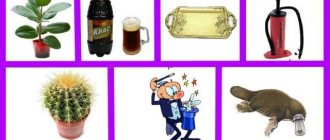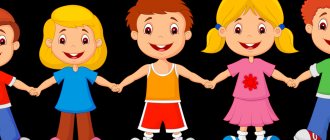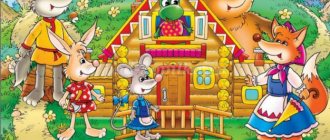Summary of neuropsychological individual correctional lessons
Nadezhda Frolova
Summary of neuropsychological individual correctional lessons
Abstract of neuropsychological individual
correctional lesson
Child/children age 5 years, girl
Contingent:
Type of dysontogenesis - delayed development (slowing down the pace of all mental development, most often resulting from mild organic lesions of the cerebral cortex (usually of a partial nature)
or long-term and severe somatic diseases
(history was not provided by the parents)
.
Neuropsychological syndrome is a functional immaturity of the right hemisphere.
Disorders identified during neuropsychological diagnostics .
Neuropsychological diagnostics were carried out according to the methodological manual “ Neuropsychological diagnostics of preschool children”, Zh. M. Glozman, A. E. Soboleva, Yu. O. Titova.
Conclusion: From the neuropsychological examination and from the graphs above, it is clear that the child showed delays in the development of emotional, somatic-spatial, color gnosis; auditory-verbal, tactile perception; dynamic praxis; decreased level of cognitive processes such as memory, intelligence; low motivation. Concentration, gross motor skills, and visual memory remain intact. According to the method, the child scored 9.2 points, which indicates a gross degree of mental retardation.
The form of the lesson is individual . This form of work with a given child will be most effective for the development of the “weakest”
mental functions, will make it possible to most fully ensure the transition from an expanded action to a collapsed one, from external to internal, from joint to independent, and will make it possible to select and dose the load regimen, taking into account the
individual characteristics of the child.
Topic: “Feed the bunnies carrots”
.
Goal: Correction of mental development disorders.
Tasks:
— Optimize the functional status of deep brain formations and the basis for the formation of subcortical-cortical and interhemispheric interactions.
— Optimize and stabilize the overall body tone.
— Relieve muscle tension and dystonia.
— Expand the sensorimotor repertoire.
— Overcome pathological rigid bodily attitudes and synkenesis.
— Form operational support for verbal and non-verbal mental processes: somatognostic, tactile and kinesthetic.
— Development of visual gnosis.
— Form basic sensorimotor (simultaneous and reciprocal)
interactions.
— Develop color gnosis.
— Form voluntary regulation and self-control of behavior.
— Increase motivation.
— Develop emotional gnosis and communication.
Equipment: Hourglass (30 min., picture with bunnies (bunnies according to the number of tasks)
A-4 format, cut out carrots according to the number of bunnies, tambourine,
neuropsychological game “Try again!”
,
neurogame “Repeat after me”
, didactic game
“Caterpillar”
, relaxation music
“Sound of the Surf”
, tree of emotions.
Lesson scenario :
turns over the hourglass at the beginning of the lesson (30 min)
and tells the child, while the sand is running, we will complete the tasks, when the sand runs out, our
lesson . At the beginning of the lesson, the teacher says that today we will feed the bunnies carrots. On the table there is a picture with bunnies and paper carrots separately. In order to feed the bunnies, you need to complete tasks. For each correctly completed task, the child receives a carrot and places it on the bunny. (This technique motivates the child to complete tasks correctly. Helps maintain the child’s persistent interest throughout the entire lesson .)
1. Greeting ritual.
Exercise “Let's say hello...”
.
The child is invited to say hello to the part of the body that the adult names. First, the child and the adult walk in a circle to the tambourine. When the music stops, the adult invites the child to say hello, for example, with his palms, then his elbows, his index finger, etc. The game continues 2-3 times. After a correctly completed exercise, the child receives a carrot and “feeds”
the bunny.
(Positive attitude exercise)
.
2. Warm up.
Breathing exercise “Let's be surprised”
(Energizer)
. I. p. - o. p., take a free breath. 1 – slowly raise your shoulders while exhaling; 2 – i. n. At this time the psychologist says:
“It’s surprising what there is,
there are countless miracles in the world.”
The exercise is repeated 2-3 times. After a correctly completed exercise, the child receives a carrot and “feeds”
bunny (Exercise to stabilize and activate the body’s energy potential, increase the plastic sensorimotor support of mental processes).
Oculomotor exercise “Help the frog move from leaf to leaf”
. The child sits upright in a chair. An adult takes a paper frog and smoothly leads it from left to right, from bottom to top, from right to left, from top to bottom, along the leaves. The exercise is repeated 2-3 times. After completion, an (exercise to remove muscle tension and expand the sensorimotor repertoire) is carried out.
Stretch "Strongman"
.
Perform contrasting tension and relaxation of the shoulder girdle, arms and legs, imagining that we are holding heavy buckets in our hands, lifting a heavy basket of apples above our heads. Repeat 2-3 times. After a correctly completed exercise, the child receives a carrot and “feeds”
the bunny.
(Exercise to optimize and stabilize the overall body tone.)
3. Exercises aimed at developing psychomotor coordination.
Finger massage with an elastic ring Su-jok “Path”
. The child puts the ring on each finger in turn, reciting the poem.
“I’m putting the ring on my finger.
And I shake it on my finger.
I wish your finger health,
I’m teaching him to be dexterous.”
After completing the exercise, the child receives a carrot and “feeds”
bunny
(Exercise to stabilize and activate the body’s energy potential, increase the plastic sensorimotor support of mental processes)
Game "Try again"
.
The child is offered cards with movements of the hands and fingers (simple)
and asked to do the same.
2-3 movements are selected and repeated 3-4 times. After completing the exercise, the child receives a carrot and “feeds”
the bunny. (Exercise on the formation of somatognostic, tactile and kinesthetic processes).
4. Exercises aimed at developing cognitive competencies.
Exercise "Labyrinth"
.
Exercise “Name what’s hidden”
(overlaid images)
.
After completing the exercises, the child receives 2 carrots and “feeds”
the bunnies.
(Exercises for the development of visual gnosis)
.
Game "Caterpillar"
.
The child is asked to lay out a caterpillar from colored circles, in accordance with the card, being sure to pronounce the colors. After completion, the child again “feeds”
the bunny with carrots.”
(Exercise to develop color gnosis)
.
5. Outdoor game.
Game "Repeat after me"
.
The game starts with a simpler option. The child is offered a card with a picture of a child showing some kind of movement. For example, move your left leg to the side, raise your arms up, clasp your hands below and open your mouth. It is suggested to perform 2-3 movements 2-3 times. After a correctly completed exercise, the child receives a carrot and “feeds”
the bunny. (Exercise to overcome pathological rigid bodily attitudes and synkenesis).
6. Ritual of completion of the lesson , summing up, farewell.
Relaxation "Beach"
.
The psychologist invites the child to lie down on the carpet and close his eyes, turns on relaxation music (sounds of the sea)
and says, “Imagine that you are lying on the warm sand and sunbathing.
The sun is shining tenderly and warming you. A light breeze is blowing. You relax and listen to the sound of the waves. Listen to your body. Are you comfortable? Try to change your position so that it is as comfortable as possible and you are as relaxed as possible. Try to imagine yourself entirely, remember this image. Stretch, take a deep breath and exhale, open your eyes, sit down slowly and get up slowly.” (Exercise to optimize and stabilize the overall body tone.)
(Exercise to optimize and stabilize the overall body tone. Relaxation.)
Psychologist: Let's remember what we did today? Which task was the easiest? What was the most difficult? Which one did you like the most? Well done, you were able to feed all the bunnies! What's your mood? Go to our mood tree, choose an acorn with a mood similar to yours and hang it up. The sand in our clock is over and so is our lesson . Goodbye!
7. List of sources used.
— Lectures “The concept of neuropsychological symptom , syndrome and factor”, “Syndromes of functional immaturity in childhood”
,
“Features of the genesis of HMF”
,
“The theory of the three main structural and functional blocks of A. R. Luria”
.
— Neuropsychological correction in childhood . Method of replacement ontogenesis. Tutorial. – 8th ed. – M.: Genesis, 2015.
— Internet resources: https://infopedia.su/8×8943.html, https://sdnp.ru/recomendatsii/.
— “Development of interhemispheric interaction in children. Neurodynamic gymnastics ”, Tryasorukova T. P. – Ed. 2nd. – Rostov n/a: Phoenix, 2021.
— Personal files of games “Complexes of breathing exercises with acupressure massage”
,
“Su-jok therapy in working with children of early and preschool age”
,
“Kinesiological exercises”
,
“Oculomotor exercises”
, exercises for the development of attention and perception
“Mazes”
, “Superimposed
(noisy)
images”,
“Games for the formation of color perception”
,
“Games for the development of emotional intelligence”
, games for the development of motor praxis
“Try to repeat”
,
“Repeat after me”
.
Homework: Do the exercises from the “Try again”
and
“Repeat after me”
for five days.
Compiled by educational psychologist
highest qualification category
Frolova Nadezhda Sergeevna
MADO "Kindergarten No. 1 "Swallow"
,
Kamchatka region, Yelizovo city
Progress of the lesson:
1. Org. moment
2. Game “Guess what disappeared”
Purpose of the game: development of attention and memory.
Equipment: 5–7 toys.
Instructions: look and remember all the toys. Close eyes. Open your eyes and guess what disappeared or appeared. Gradually increase the number of toys.
3. Game "Shepherd"
The goal of the game is to develop the ability to concentrate and distribute attention.
Equipment: a poster with a picture of a herd of grazing cows, a sheet with a picture of one cow.
Instructions: help the shepherd find the cow by signs ( the child is given a sheet with a picture of a cow that he needs to find on the poster).
The child needs to concentrate on several signs: the coloring features of the body, the shape and color of the horns , body, etc.
4. Finger gymnastics
1. Palms on the table (on the count of “one-two”, fingers apart - together.)
2. Fingers shake hands (on the count of “one-two-three-four-five” the fingers of both hands are connected: thumb to thumb, index to index, etc.)
3. Little man (the index and middle fingers of the right and then the left hand run across the table).
5. Game “It happens - it doesn’t happen”
Goal: development of thinking.
Equipment: ball
Progress of the game: the teacher names some situation and throws the ball to the child . The child must catch the ball if the above situation occurs, and if not, then the ball must be returned. Different situations can be offered: dad went to work; a train flies across the sky; the cat wants to eat; the postman brought a letter; salted apple; the house went for a walk; glass shoes, etc.
6. Summary of the lesson : please tell me what we talked about during the lesson ? Remember what games you played.
Lesson 2
Topic: “ Formation of the child’s intellectual sphere ”
Goal: development of mental processes .
Tasks:
1. Development of imagination;
2. Development of short-term memory;
3. Development of thinking;
4. Development of fine motor skills.
Progress of the lesson:
1. Org. moment
2. Game “What’s extra?”
Goal: development of thinking.
Equipment: cards with images of objects
Progress of the game: Place in front of the child three cards belonging to one semantic group, and the fourth from another group (transport and building; animals and a toy; dishes and a book, etc.)
.
The child must highlight the extra card.
3. Finger gymnastics.
1. Goat (extend the index finger and little finger of the right hand, then the left hand)
.
2. Little goats (the same exercise, but performed simultaneously with the fingers of both hands)
.
3. Hares (extend the index and middle fingers upward, connect the thumb, little and ring fingers).
4. Game “Do it as it was”
.
Goal: memory development.
Equipment: 5 pairs of subject pictures and a white A4 .
Instructions: look carefully and remember all the pictures. Put it the way it was.
Help: re-show in case of difficulty.
5. Game “Let’s invent”
Goal: development of imagination.
Equipment: a set of objects of different shapes (sticks, ball, ring, boxes, cylinder)
and cards with images of different objects of a certain
shape - mirror , pencil, egg, apple. The images in the pictures should be similar to objects. For example: a pencil, a fishing rod, a needle, a knife - similar in shape to a stick ;
vase, glass, thimble - a hollow cylinder. Progress of the game: the child sits down at the table , various objects lie in front of him. The teacher sits opposite him and has cards with pictures. The psychologist shows the cards one at a time and asks: What object is like a pencil? The child must find a similar one from a set of objects.
6. Summary of the lesson : what animals did we remember during the lesson ? Remember what games you played.
Lesson 3
Topic: “ Formation of the child’s intellectual sphere ”
Goal: development of mental processes .
Tasks:
1. Development of auditory perception;
2. Development of imagination;
3. Development of thinking;
4. Development of fine motor skills.





